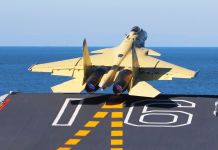While India celebrated its Navy Day with the theme that the force is “Combat Ready, Cohesive and Credible”, the event has exposed once again the apparent lack of cohesion in the country’s military establishment, with the Chief of Defense Staff (CDS) and the Chief of the Naval Staff (CNS) differing on India’s need for a three-carrier-based force structure.
What Lies Ahead For India & China As Donald Trump’s Loyalist Take Control Of The Pentagon?
Ever since he assumed office as the CNS on May 31, 2019, Admiral Karambir Singh has been advocating three aircraft carriers for India, so that two are operational at all times.
On the other hand, General Bipin Rawat, the former Army Chief who joined the newly created post of the CDS on January 1 this year, thinks otherwise. He has openly argued that the Navy’s priorities should be submarines, not aircraft careers.
However, the CNS remains defiant. On the eve of the Navy Day on Thursday, he told the press very categorically that the Navy believes that a third aircraft career is a great necessity.
Financial Versus Strategic Concerns
All told, a three-career-based forced structure for the Navy had been accepted in principle till the CDS raised questions about its feasibility.
The Indian Navy currently operates one carrier, the 45,000-ton INS Vikramaditya procured from Russia, with a second but indigenously built 37,500-ton INS Vikrant all set to undertake early next year. Both are “ski-jump” carriers. But the Indian Navy regards the planned third and indigenously built “ flat-topped” 65,000-ton INS Vishal, with superior power projection capabilities, as vital for its ever-enlarging role in the Indo-Pacific.
The CDS-CNS divergence over the careers seems to have both financial and strategic dimensions.
Financially speaking, India had a bitter experience in acquiring Vikramaditya, which was rechristened after a refurbishment of the carrier Gorshkov. The Russians hiked the originally agreed price of $974 million to $2.35 billion. And then, together with 45 MiG-29K aircraft and additional modifications, they raised the overall price to something in between $6 billion and $7 billion.
The Vikrant is about to cost in the range between $10–11 billion. And if India goes ahead with the planned Vishal, then the ship, along with the likely aerial component of F-18E or Rafale, will probably cost in the order of $16–17 billion at current prices over a time span of at least 10 years.
Can the ailing Indian economy, further hit by Covid-19, afford this sum? The question is all the more relevant when the Navy, which has only about 15 percent of the total defense budget of the country in recent years, has a long list of other and more vital requirements. As it is, the Indian defense budget allocation over the last two years has been the lowest since the early 1960s, and now the Covid-19 impact has made things worse.
Strategically speaking, the debate is over whether without a third career the Navy can be cost-effective and yet remain an effective force with a powerful punch. The likes of General Rawat think that with powerful and credible submarines, the Indian Navy can very effectively counter both China and Pakistan, India’s two principal adversaries.
Aircraft Carriers Or Submarines?
With a relatively cost-effective and yet modern submarine fleet, India can engage in successful “sea-denial” to China and Pakistan, launch attacks on Pakistani land-based assets using cruise missiles, and be the essential part of a second-strike capability for India’s nuclear force. A sea denial strategy means denying the adversary use of a sea area for a certain duration.
Professor Amit Gupta, who heads the Alternative Security Forum in Montgomery, Alabama, USA, says that a flotilla of frigates, destroyers, and submarines backed by air assets from shores can create a blockage of oil supplies that would grind Pakistan’s war-making capacity to a halt within 10-14 days.
This, according to him, will be more effective than an aircraft carrier that would be busy expending efforts to defend itself against Pakistani missiles and submarines.
Similarly, Prof Gupta argues that an Indian submarine fleet could inflict considerable damage on a Chinese naval fleet that tries to break out of the Malacca Strait. Moreover, land-based IAF Sukhois would be able to interdict Chinese naval vessels, especially with the new Brahmos missiles that have been acquired for the Air Force.
Incidentally, there is now a global realization that apart from the huge costs involved in operating them, aircraft careers are increasingly becoming vulnerable to attacks not only from the sophisticated submarines but also from both land-based and ship-based missiles.
Submarines do not have to get that close to do harm; they, like surface ships and aircraft, can also launch increasingly sophisticated anti-ship missiles from far afield. China’s H-6k bomber, for instance, has a range of 3,000km, and its YJ-12 cruise missiles another 400km. If that is the case, then why should not India learn this Chinese lesson?

But then, there are counterarguments in favor of having multiple careers. The likes of CNS Singh point out that the carriers are not without defenses. Their own aircraft can protect them from incoming bombers. The escort vessels around and below them ward off unfriendly submarines and shoot down incoming missiles. Careers do have guided-missile destroyers that accompany them. They are also well-equipped with their own missile-defense systems.
Besides, since carriers are hardly static and usually on a move, bringing together different sorts of satellite and drone data to update targeting information on before launching missiles will not be easy.
In projecting one’s maritime power and controlling the sea, nothing can substitute a carrier, so runs this line of argument. The Indian Maritime Doctrine defines sea control as “a condition where one is able to use a defined sea area, for a defined period of time, for one’s own purposes and at the same time deny its use to the adversary”.
Carriers Vital For Expanding India’s Influence
Thus Indian carriers give the country a political advantage in its multinational operations in the Indo-Pacific. As India shows that it is a stakeholder in a liberal-democratic international system, it will be using its Navy in operations such as anti-piracy and interdiction of rogue proliferators, admits Prof. Gupta.
In such operations, aircraft carriers are invaluable since they can be at sea for extended periods of time to conduct surveillance and interdiction of pirates or in tracking vessels carrying weaponry (as was the case when a North Korean ship carrying missile parts was successfully interdicted by the Indian Navy in the Indian Ocean).
Aircraft carriers do well also in projecting “soft power” of the country by providing humanitarian assistance in countries affected by natural disasters by providing relief material and evacuating personnel. They are also good for showing the flag in countries like the Maldives or even potentially Fiji where Indian interests are at stake.
According to Cmde. Roby Thomas, a Senior Fellow at the Manohar Parrikar Institute for Defence Studies and Analyses, New Delhi, as India has close to 1200 island territories, they can be best protected by a carrier battleship, because the mainland-based aircraft and amphibious operations have severe limitations.
That explains why countries involved in global roles or aspiring to play such roles do have or about to procure aircraft carriers in their naval inventories. The US operates 11 nuclear-powered carriers. The United Kingdom recently commissioned HMS Queen Elizabeth, with a second carrier, HMS Prince of Wales, in the final stages of construction.
Russia, Italy, and France all operate one aircraft carrier each, while Japan is in the process of converting its helicopter carrier into an aircraft carrier. China has now two carriers under operation and is constructing a third one; in fact, it plans to have 10 carriers by 2049.
Will India remain far behind? That is the question that perhaps troubles CNS Singh.




